Environment
405 articles

Mud rain is a meteorological phenomenon associated with arid and semi-arid conditions. Also known as rain dust, it manifests due to the interaction between soil dryness, lack of vegetation and dust storms. It is generally more prevalent during spring and summer, depending on the regions. The presence of dust...

Eukaryotic cells are the fundamental building blocks of life, forming the structural and functional basis of plants, animals, fungi, and protists. These cells are distinguished by their complex internal organization, featuring a true nucleus, membrane-bound organelles, and a cytoskeleton. In contrast to simpler...

In the realm of biology, reproduction is a fundamental process that ensures the continuity of life. While sexual reproduction, involving the fusion of male and female gametes, is the predominant mode, plants exhibit a remarkable diversity in their reproductive strategies. Among these, apomixis stands...

The cell nucleus is a cellular organelle of eukaryotes. These are the subcellular structures which allow the cell to carry out its functions. The nucleus is the largest organelle of eukaryotic cells, a type of cell found in all animals and plants. The parts of the cell nucleus include the nuclear envelope,...

Soil science is the study of soil, a complex natural system that plays a vital role in agriculture, environmental protection, and human health. Soil is a mixture of minerals, organic matter, air, and water that supports plant growth and provides habitat for a wide range of organisms. Soil scientists study...

Glacial moraines are large deposits of debris which are left over from the movements of glaciers. However, they are not simply waste byproducts created by glaciers. When we observe the structure and form of glaciers, we can see they are divided into various parts. The moraine is a fundamental part of this...

Urban forests, also known as city forests or urban green spaces, represent the vital green lungs within urban environments. Comprising trees, vegetation, and greenery strategically placed within cities, these spaces play a crucial role in enhancing the urban landscape, human health, and overall ecological...

Peatlands are a type of wetland which contain peat, a substance made from accumulated partially decomposed organic matter. When this peat reaches a certain standard, it can be used for fuel. Peatlands can be found in approximately 180 countries, in different climatic zones. Peat in its moist state serves...

Geographical space is a term used in the field of geography to describe the particular way in which a society is organized within a physical space. This means that it is a concept which is important to both human and physical geography. We can understand this concept best by looking at how societies...

The salinization of aquifers is when these freshwater groundwater reservoirs become saline, i.e. water that has more dissolved salts than fresh water should contain. Aquifers contain much of the world's water resources since they often contain salt water which we can use for drinking and many other purposes...

All types of aquifers are important for the water cycle below the Earth's surface, but the different types affects their function. For this part of the water cycle, rainwater infiltrates the ground, occupying pores and cracks in the subsoil, giving rise to underground runoff. Water is stored in aquifers...

Water resources are the natural sources of water which are useful to human society. While this water will be important for all life on the planet, it is sometimes not directly accessible to other forms of terrestrial animals. This means these water resources need to be extracted. While there is an abundance...

The different types of coral species can be grouped into the two main categories of stony and soft corals. Unlike some other cnidarian species, corals only have a polyp stage. This means they remain sessile and attached to another surface. Since they are also typically colonial organisms, groups of these...

El Niño, meaning "the little boy" in Spanish, is a climate pattern characterized by a significant warming of the surface waters in the central and eastern equatorial Pacific Ocean. This warming, which typically occurs every two to seven years, is not a mere regional affair; it's a global game-changer,...

Geodiversity encompasses a variety of geological and geographical elements which make up our planet Earth. This includes the various types of rock formation which are themselves made up of composite minerals which interact in fascinating ways. We can see such geodiversity in soils which not only vary...

Understanding the difference between organic and inorganic compounds is a fundamental principle in chemistry. Essentially, the difference between inorganic vs. organic matter is to do with the presence of carbon. Although this is important on a molecular level, it is a topic which has a great impact on ecology....

A snow avalanche is an imposing and potentially dangerous natural phenomenon that occurs when snow rapidly proceeds down a slope. These can be very small, but the larger the avalanche, the more destructive it will be. We often don't know the direct cause of a snow avalanche, but we do know there are...

Green cities are those which are specifically designed or adapted in such ways they reduce their environmental impact and make life better for its citizens. While all cities will have some level of vegetation incorporated into their infrastructure, this does not make them green cities. A green city is...

The environmental impact of diesel and gasoline cars is a complex and controversial topic. Both types of cars produce emissions that can harm the environment and human health. However, the specific types and amounts of pollutants emitted vary depending on the type of car and its driving conditions.
In...

Torrential rains are a weather phenomenon where an intense and abundant precipitation of water occurs over a certain period of time. They are often relatively short, which is why we refer to them as a torrential downpour to compare them to lighter rains. Unfortunately, torrential rains can also occur...

Landslides are the downward movement of a mass of soil, rock, debris, or a combination of these materials along a slope or hillside. They can be caused by a variety of factors, including heavy rainfall, earthquakes, volcanic eruptions, and human activities such as deforestation and road construction....

The difference between haploid and diploid cells concerns the chromosomes found within the nucleus of cells. Nuclei of eukaryotic cells contain the genetic information that results in how an organism is formed and functions. This information is packed very compactly into structures known as chromosomes....

A biome is a large-scale ecosystem that is characterized by its unique climate, vegetation, and wildlife. Biomes are classified based on their temperature, precipitation, latitude, altitude, plant structure, leaf types, spatial distribution of plants, and ecological succession. From the lush rainforests...

Have you ever looked out your window on a foggy morning and marveled at the ethereal beauty of the scene? Or perhaps you've driven through a haze-filled landscape, its otherworldly quality both mesmerizing and disorienting. Fog, mist, and haze are all atmospheric phenomena that can reduce visibility,...

The Foehn effect is related to a dry, warm wind that moves along the downward side of a mountain. It occurs when an air mass encounters this mountainside and is forced to ascend up it. This natural phenomenon occurs in most mountainous regions of the world, although it is a localized effect. Foehn winds...

Floods are a natural disaster that can be caused by a variety of factors, including natural meteorological phenomena, human-induced construction and activities, and climate change. While some floods are uncontrollable and unpredictable, others can be prevented or mitigated with proper planning and management.
This...

Fog is a weather phenomenon that is essentially a low-flying cloud. This is because it is an aerosol of water or ice droplets that moves close to the Earth's surface. It can be a very evocative phenomenon, either creeping over rolling hills in the countryside or descending ominously over a cityscape. While...

Waterspouts are a weather phenomenon which appear as if a tornado has formed over a large body of water. They consist of eddies that are usually connected to cumuliform clouds. The base of a waterspout can be formed by water spray. This meteorological phenomenon is frequently confused with tornadoes that...

The journey of life originates in our genes. They hold the key to an individual's physical characteristics, behaviors, and biochemistry. Among these genetic aspects, we find the genotype and the phenotype. Though closely intertwined, they are unique in their roles and characteristics.
In this article...

Seeds are remarkable and fundamental components of the plant kingdom. They serve as the means through which plants reproduce and spread their genetic material. Seeds come in a stunning array of shapes, sizes, and adaptations. Different plants have evolved seeds that are uniquely suited to their specific...

The term "cold drop" refers to a recurring meteorological event that occurs yearly, primarily impacting the weather along the Mediterranean side of the Iberian Peninsula. It unfolds when a pocket of cold air above descends and disconnects from the main cold air mass. This phenomenon gives rise to various...

Speciation is a fundamental process in evolutionary biology that involves the formation of new distinct species from a common ancestral population. This process plays a critical role in the diversification of life on Earth, leading to the incredible variety of species that inhabit our planet. There are several...

Hurricanes, often referred to as tropical cyclones or typhoons in different regions of the world, are awe-inspiring meteorological phenomena. These immense storms, characterized by powerful winds and torrential rains, can unleash catastrophic forces of nature upon the areas they make landfall. Hurricanes...

The human propensity for waste generation has expanded beyond the boundaries of Earth. The growing volume of debris encircling our planet presents a tangible peril to telecommunications, space missions, and the spatial realm itself. Once part of our exploration and communication endeavors, this collection...

In July 2023, experts underscored the exceptional and previously unseen nature of the temperatures reached in the summer of 2023. Their investigation revealed that July 2023 set a new record for the highest ever recorded. Furthermore, it marked an unprecedented occurrence by registering the three highest temperatures...

Aquaculture is a set of activities, techniques and knowledge on the cultivation of aquatic plant and animal species. Different areas will have their own specialized crops and livestock depending on their requirements. As a farming model, aquaculture provides many advantages such as reducing the overexploitation...

Haze is a meteorological phenomenon which is occurs when a large concentration of particles is present in the atmosphere. These particles may be in the form of dust, sand, ash or various pollutants. The levels of hazy weather conditions can vary. They can also be confused with other conditions such as...

The world's seas and oceans are currently facing significant environmental challenges, including pollution, which have a notable impact on fisheries. One of the most pressing issues in recent years is overfishing. It is not only a concern in marine environments but also affects terrestrial ecosystems due to activities...

Forest fires, also known as wildfires, are natural or human-induced infernos that ravage vast expanses of wooded areas, leaving destruction and ecological impacts in their wake. These fires are a formidable force of nature, capable of spreading with astonishing speed and intensity, fueled by the abundance...

Riverbanks are ecosystems that line the shores of rivers, creating a seamless transition between the aquatic and terrestrial worlds. These dynamic zones are teeming with life, hosting a rich variety of flora and fauna uniquely adapted to the distinct conditions they offer. As well as providing shelter and...

Nestled at the meeting point of land and sea, mangroves make up a complex and fascinating coastal ecosystems. These habitats are known for their rich biodiversity, exceptional adaptations and ecological importance. Mangroves have evolved special strategies to thrive in diverse habitats, including their remarkable...

The most venomous fish in the world are mostly from marine environments, although we cannot forget freshwater venomous fish such as catfish. The most deadly are certainly those found in saltwater environments. Many of us may associate venom with terrestrial animals such as snakes or spiders. In actuality,...

Cross contamination in food preparation occurs when there is a transfer of various types of material which can result in food causing harm. This is often the case when microorganisms are spread from one food to another, resulting in the food become toxic to anyone who consumes it. However, there are...

Zooxanthellae are symbiotic photosynthetic microalgae. Their symbiosis occurs with certain species of corals, anemones or jellyfish, as well as the giant clam (Tridacna gigas). The life cycle of zooxanthellae begins with asexual division, forming flagellated cells that later lose mobility. Their function...

Explore the fascinating world of microalgae, a diverse and intricate realm teeming with tiny yet extraordinary organisms. Despite their diminutive size, these microorganisms hold immense significance in shaping our planet's ecosystems and supporting life as we know it. From environmental sustainability to...

Soft corals are a mesmerizing and diverse group of marine organisms that captivate the imagination with their unique beauty and intriguing characteristics. Unlike their stony counterparts, these corals do not build rigid calcium carbonate skeletons, leading to their name "soft corals." Instead, they showcase an array...

The differences between seas and oceans is not simply due to terminology. The two terms are often used interchangeably, both referencing large marine bodies of saltwater. Despite certain similarities in the two concepts, seas and oceans are not the same. One of the key differences between seas and oceans...

Mid-ocean ridges (MORs) are geological formations found at the bottom of oceans. At first glance, they may appear to be simple seamounts (underwater marine mountains), but their composition is both more complicated and more impactful on the ocean ecosystems in which they are located. Mid-ocean ridges, are long...

The gorgonian coral is a type of soft marine coral that belongs to the family Gorgoniidae. There are various genera within this group, all of which are types of Cnidarian, members of the phylum which also includes jellyfish, sea anemones and other marine species. Despite being part of the same taxonomic...

Chordates encompass a diverse and fascinating group of animals, characterized by a set of unique anatomical features that define their evolutionary lineage. From the mighty blue whale to the unassuming lancelet, chordates span a wide range of species, inhabiting diverse ecosystems across the globe. What sets...
